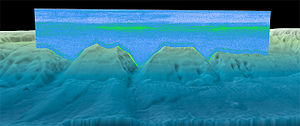Deep scattering layer

The deep scattering layer, sometimes referred to as the sound scattering layer, is a layer in the ocean consisting of a variety of marine animals. It was discovered through the use of sonar, as ships found a layer that scattered the sound and was thus sometimes mistaken for the seabed. For this reason it is sometimes called the false bottom or phantom bottom. It can be seen to rise and fall each day in keeping with diel vertical migration.
Sonar operators, using the newly developed sonar technology during World War II, were puzzled by what appeared to be a false sea floor 300–500 metres (980–1,640 ft) deep at day, and less deep at night. Initially, this mysterious phenomenon was called the ECR layer using the initials of its three discoverers.[2] It turned out to be due to millions of marine organisms, most particularly small mesopelagic fish, with swim bladders that reflected the sonar. These organisms migrate up into shallower water at dusk to feed on plankton. The layer is deeper when the moon is out, and can become shallower when clouds pass over the moon.[3] Lanternfish account for much of the biomass responsible for the deep scattering layer of the world's oceans. Sonar reflects off the millions of lanternfish swim bladders, giving the appearance of a false bottom.[4]
Description

The phantom bottom is caused by the sonar misinterpreting as the ocean floor a layer of small seagoing creatures that congregate between 1,000 and 1,500 feet (300 and 460 m) below the surface.
Most mesopelagic organisms, including
In 1998, sampling via deep trawling indicated lanternfish account for as much as 65% of all deep sea fish biomass.[11] Lanternfish are among the most widely distributed, populous, and diverse of all vertebrates, playing an important ecological role as prey for larger organisms. The previous estimated global biomass of lanternfish was 550–660 million tonnes, about six times the annual tonnage captured worldwide by fisheries. However, this was revised upwards as these fish have a special gland for detecting movement from up to 30 metres away (e.g. fishing nets and fish sampling nets). In 2007 global sonar detectors indicated a more accurate figure for the global biomass was between 5,000 and 10,000 million tonnes: a truly massive weight of living mass.[4][12]
See also
References
- ^ a b Water Column Sonar Data National Geophysical Data Center, NOAA.
- USS Jasperin 1942...
- ^ Ryan P "Deep-sea creatures: The mesopelagic zone" Te Ara - the Encyclopedia of New Zealand. Updated 21 September 2007.
- ^ a b R. Cornejo, R. Koppelmann & T. Sutton. "Deep-sea fish diversity and ecology in the benthic boundary layer". Archived from the original on 27 September 2007.
- ISBN 978-1-4532-1476-3. Retrieved 20 June 2013.
- ^ ISBN 978-0-8070-8547-9. Retrieved 20 June 2013.
- ^ Moyle and Cech, 2004, p. 585
- ^ Bone & Moore 2008, p. 38.
- S2CID 43485719.
- ^ Douglas EL, Friedl WA and Pickwell GV (1976) "Fishes in oxygen-minimum zones: blood oxygenation characteristics" Science, 191 (4230) 957–959.
- ISBN 978-0-12-547665-2.
- ^ Rowan at Facts in Motion. "How this tiny fish is cooling the planet". YouTube.
Further references
- Bone Q and Moore RH (2008) Biology of Fishes Taylor & Francis Group. ISBN 978-0-415-37562-7
External links
- Deep scattering layer Britannica online.


